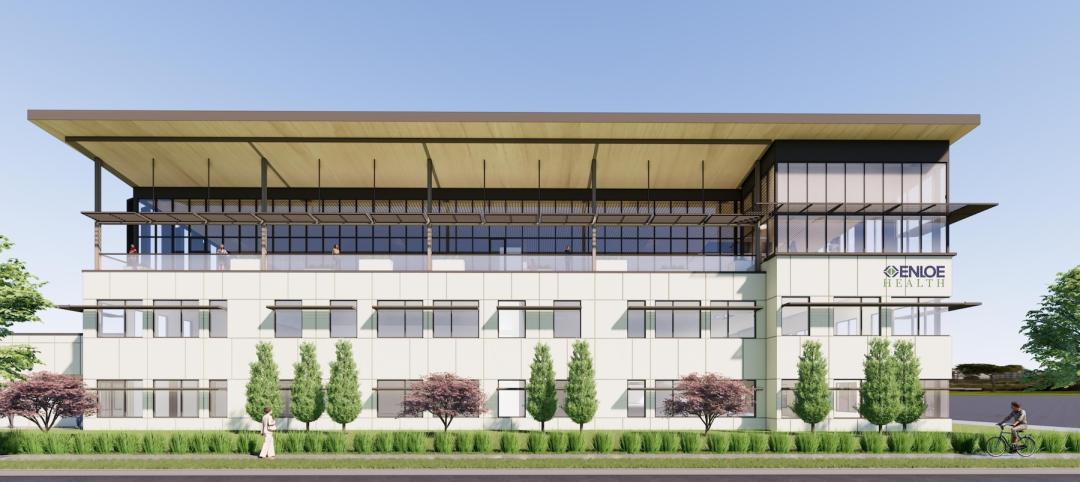“Collaboration” has become an abiding design goal for many nonresidential building types, such as offices and educational institutions. But the medical field, with its hierarchical divisions and silo mentality among professionals, continues to resist a more collaborative workplace culture.
Perkins Eastman set out to find out why, and used one of its own projects—the 95,000-sf NYU Winthrop Hospital Research and Academic Center in Mineola, N.Y.—as a test case a year after it opened in 2015.
The firm's post-occupancy evaluation—whose findings it published in a recently released white paper “The Effectiveness of Collaborative Spaces in Healthcare and Research Environments”—focuses on the activities within a third-floor multi-use space in the facility that the firm designed specifically with employee interaction in mind.
The white paper touches on the evolution of collaborative design, and singles out two examples—Bell Labs’ headquarters in Murray Hill, N.J., in the 1960s, and Google’s national headquarters in Mountain View, Calif.—where cross-disciplinary collaboration took root and where “activity based” working is now on full display.
The paper notes that offices and education facilities are creating these kinds of environments by planning for collaboration early in the design process, “to include a variety of different kinds of areas to support one-on-one, individual, small group and large groupings.”
However, even the most thoughtfully designed space won’t lead to meaningful change in a workspace if it isn’t supported by policies and attitudes that foster collaboration. And that support is what Perkins Eastman found was missing at NYU Winthrop Research and Academic Center.
Its third-floor space was seen as a microcosm of Perkins Eastman’s design intent. Its programmatic elements include a pantry with small cook and prep area and two vending machines, a café dining space with tables and chairs, a break area with soft seating, a low four-person conference table and sit-up bar; a work room with a TV, tablet chairs and writable magnetic wall; a research area with a large writable wall, movable ottomans, and high-top tables and writing table tops; and a conference room with a large executive meeting table, digital projection capabilities, wet bar and seating banquette.

To assess employee engagement in a multi-use space within NYU Winthrop's Research and Academic Center, Perkins Eastman observed and place-mapped activities over a nine-hour period in several time intervals. It found scant indepartmental connectivity, and virtually no use of this space for work. Image: Perkins Eastman
Perkins Eastman observed and place-mapped employee interactions in that space over a nine-hour period in four intervals during the day. The firm tracked how long people spent in any one place, and what they were doing. It also noted whether people were alone or in groups.
“Very little interaction among users from different departments was observed,” Perkins Eastman found. Most people used to space to eat their lunches or talk on their phones. And they usually hung out with people from their own departments. “No spontaneous meetings of small or large groups were observed, and the amenities provided to support impromptu collaboration…went unused.”
Subsequent interviews with 17 user groups from various departments found that while employees generally like the space, they didn’t know how to use it other than to eat lunch or buy food from the vending machines.
None of the people interviewed used the space for work, primarily because their jobs require computers and other tools located at their designated workstations. More surprising, though, was the finding that many of the interviewees weren’t sure if they were even allowed to use the third-floor space for meetings or presentations. In fact, they were “simply uninformed about the potential uses of the third-floor space,” the white paper reports.
Perkins Eastman found that most doctors, researchers, nurses, and administrators within the user groups interviewed would like to collaborate. But a suggestive design wasn’t enough to instigate that interaction. “The faculty and staff needed to be shown how to use the third-floor in order to promote its use as a collaborative space.”
The white paper concedes that research often requires quiet, focused study supported by specialized workstations or lab equipment. And the need for privacy can be a barrier to collaborating in a healthcare environment.

The white paper provides ways that medical centers could encourage collaborative use of their common spaces. The suggestions revolve around providing workers with more imformation about the potential uses of those areas. Image: Perkins Eastman
But there are “simple measures” that the Center could do to foment collaboration and communication, at least in the multi-use space with an open floor plan. These include:
•Create a schedule of programs and presentations for that space
•Assign an IT specialist to educate and assist users with technologies provided in the workroom and conference room
•Post information and signage that suggests how the space can be used
•Orient new employees about how to use the space, and
•Provide greater spatial variety, and the ability to close certain spaces for private meetings. (A number of interviewees said they didn’t conduct meetings on the third floor because none of the rooms could be closed off.)
In the final analysis, Perkins Eastman remains convinced that design, reinforced by programming, can support collaboration and employee engagement within a medical building. But the medical profession also needs to shift toward a more positive attitude about collaboration. “If users are uninformed about the potential uses of a space, it is difficult for a culture of collaboration to thrive.”
Related Stories
Healthcare Facilities | May 28, 2024
Healthcare design: How to improve the parking experience for patients and families
Parking is likely a patient’s—and their families—first and last touch with a healthcare facility. As such, the arrival and departure parking experience can have a profound impact on their experience with the healthcare facility, writes Beth Bryan, PE, PTOE, PTP, STP2, Principal, Project Manager, Walter P Moore.
MFPRO+ News | May 21, 2024
Baker Barrios Architects announces new leadership roles for multifamily, healthcare design
Baker Barrios Architects announced two new additions to its leadership: Chris Powers, RA, AIA, NCARB, EDAC, as Associate Principal and Director (Healthcare); and Mark Kluemper, AIA, NCARB, as Associate Principal and Technical Director (Multifamily).
Healthcare Facilities | May 21, 2024
A collaborative delivery contract adds a new wrinkle to construction management
The setup combines traditional pact structures with a different risk-sharing approach.
Healthcare Facilities | May 6, 2024
Hospital construction costs for 2024
Data from Gordian breaks down the average cost per square foot for a three-story hospital across 10 U.S. cities.
Sponsored | Healthcare Facilities | May 3, 2024
Advancing Healthcare: Medical Office Buildings at the Forefront of Access and Safety
This article explores the pivotal shift from traditional hospital settings to Medical Office Buildings (MOBs), focusing on how these facilities enhance patient access. Discover the key drivers of this transformation, including technological advancements, demographic trends, and a growing emphasis on integrated, patient-centered care. Learn how MOBs are not only adapting to modern healthcare demands but are also leveraging modern access control and safety innovations.
Architects | May 2, 2024
Emerging considerations in inclusive design
Design elements that consider a diverse population of users make lives better. When it comes to wayfinding, some factors will remain consistent—including accessibility and legibility.
Healthcare Facilities | Apr 16, 2024
Mexico’s ‘premier private academic health center’ under design
The design and construction contract for what is envisioned to be “the premier private academic health center in Mexico and Latin America” was recently awarded to The Beck Group. The TecSalud Health Sciences Campus will be located at Tec De Monterrey’s flagship healthcare facility, Zambrano Hellion Hospital, in Monterrey, Mexico.
Healthcare Facilities | Apr 11, 2024
The just cause in behavioral health design: Make it right
NAC Architecture shares strategies for approaching behavioral health design collaboratively and thoughtfully, rather than simply applying a set of blanket rules.
Healthcare Facilities | Apr 3, 2024
Foster + Partners, CannonDesign unveil design for Mayo Clinic campus expansion
A redesign of the Mayo Clinic’s downtown campus in Rochester, Minn., centers around two new clinical high-rise buildings. The two nine-story structures will reach a height of 221 feet, with the potential to expand to 420 feet.
Products and Materials | Mar 31, 2024
Top building products for March 2024
BD+C Editors break down March's top 15 building products, from multifamily-focused electronic locks to recyclable plastic panels.

















